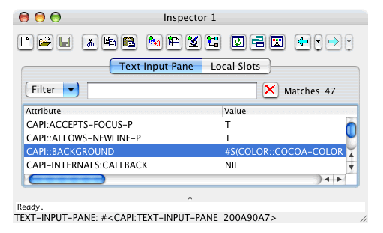*
.
If you have followed this tutorial so far, the text input pane object that you created above is returned. This is because the
capi:
contain
function returns the object that is being contained. You can easily inspect this object more closely in the Inspector tool.
This creates an Inspector tool which displays the
capi:text-input-pane
object currently contained in
*
.
Figure 2.5 Examining a text input pane in the Inspector


The commands in the
Values
menu always act upon the current value of
*
. This enables you to pass a value easily from one tool to another.
The main part of the Inspector is a list of all the slots in the object being inspected. This list shows both the name of each slot and its current value. Above this list is a box labeled Filter. This lets you filter the information shown in the main list, which can be useful when you are inspecting objects with a large number of slots. The name of the object being inspected appears immediately below the echo area.
text
.This restricts the display in the Inspector to only those items which contain the string "text", either in the slot name or in the slot value.
After using the filter, you can easily see that one of the available slots contains the word
hello
that you typed into the text input pane.
The Inspector always displays the actual instantiation of a given object (as opposed to a copy of it), so that you can be certain that any changes to the object itself are reflected in the Inspector.
If you can no longer see it, choose Window > Container ; this is a simple way to display any of the windows and tools that you have created so far. (There are actually two windows with this name; if you choose the wrong one first of all, then just choose the other one.)
hello
. Type
goodbye
and press
Return
.The description of the text slot now reflects the new value you specified.





